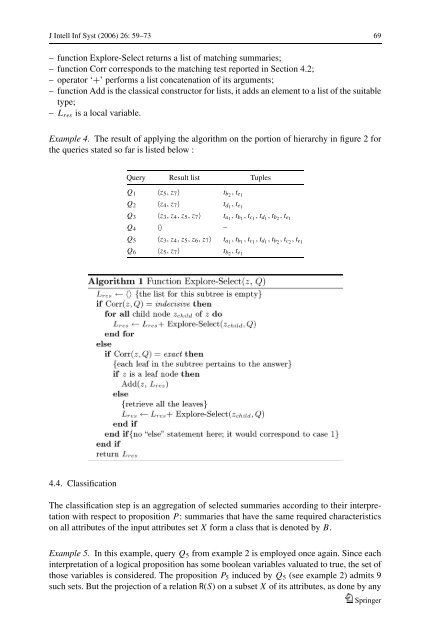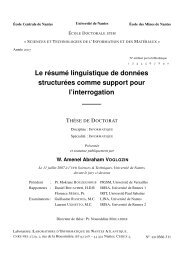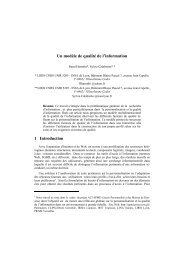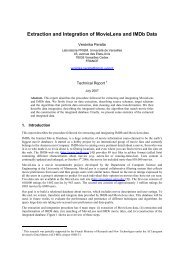68 J Intell Inf Syst (2006) 26: 59–73Fig. 3 Comparison <strong>of</strong> descriptor sets L Ai (z) and C iappear in z 2 . Consequently, v(P 6 (z 2 )) = TRUE. However, no material that matches Q 6 can befound. None <strong>of</strong> the 3 candidates covered by z 2 (see table 3) is an answer <strong>of</strong> Q 6 .This example exhibits the necessity to search leaf nodes <strong>of</strong> summaries which are supposedto match the query.While confronting a <strong>summary</strong> z with a query Q, three cases might occur:– Case 1: no correspondence. For (at least) one attribute A i , the set <strong>of</strong> required labels C i andthe set <strong>of</strong> the <strong>summary</strong> labels L Ai (z) have an empty intersection. Thus v(P(z)) = FALSE.In other words, for one attribute or more, z has no required characteristic, i.e., it showsnone <strong>of</strong> the descriptors mentioned in query Q.– Case 2: correspondence. The <strong>summary</strong> being confronted with query Q matches its semantics.It is considered a result if all attributes are one-valued (the <strong>summary</strong> is a leaf). Thefollowing expression holds: v(P(z)) = TRUE and ∀i, L Ai (z) ⊆ C i .– Case 3: no decision can be made. There is (at least) one attribute A i for which <strong>summary</strong>z exhibits one or many descriptors besides those strictly required (i.e., those in C i ):∃i, L Ai (z) − C i ≠∅.The presence <strong>of</strong> required characteristics in each attribute <strong>of</strong> z suggests, but does not guarantee,that results may be found in the subtree starting from z. Exploration <strong>of</strong> the subtreeis necessary to retrieve possible results: for each branch, it will end up in situations categorizedby case 1 or case 2. Thus, at worst at leaf level, an exploration leads to acceptingor rejecting summaries; the problem <strong>of</strong> indecision is always solved.The situations stated above reflect a global view <strong>of</strong> the matching <strong>of</strong> a <strong>summary</strong> with aquery. They can also be interpreted, from a crisp set point <strong>of</strong> view, as a combination <strong>of</strong>comparisons, still involving L Ai (z) and C i , concerning one required attribute A i . Figure 3shows the possible relative positions <strong>of</strong> L Ai (z) and C i and which case they relate to.4.3. Selection algorithmThis section applies the matching procedure from the previous section over the whole set <strong>of</strong>summaries organized in a hierarchy.Since the selection should take into account all summaries that correspond to the query,exploration <strong>of</strong> the hierarchy is complete. The selection (Algorithm 1) is based on a depth-firstsearch and relies on a property <strong>of</strong> the hierarchy: the generalization step in the SAINTETIQmodel guarantees that any descriptor that exists in a node <strong>of</strong> the tree also exists in eachparent node. Conversely, a descriptor is absent from a <strong>summary</strong>’s intension if and only ifit is absent from all subnodes <strong>of</strong> this <strong>summary</strong>. This property <strong>of</strong> the hierarchy (which canbe easily seen in Table 2) permits branch cutting as soon as it is known that no result willbe found. Depending on the query, a part <strong>of</strong> the hierarchy only is explored. In any case, allrelevant results, and only relevant results, are captured.Algorithm 1 describes the exploration and selection function with the following assumptions:Springer
J Intell Inf Syst (2006) 26: 59–73 69– function Explore-Select returns a list <strong>of</strong> matching summaries;– function Corr corresponds to the matching test reported in Section 4.2;– operator ‘+’ performs a list concatenation <strong>of</strong> its arguments;– function Add is the classical constructor for lists, it adds an element to a list <strong>of</strong> the suitabletype;– L res is a local variable.Example 4. The result <strong>of</strong> applying the algorithm on the portion <strong>of</strong> hierarchy in figure 2 forthe queries stated so far is listed below :Query Result list TuplesQ 1 〈z 5 , z 7 〉 t b2 , t e1Q 2 〈z 4 , z 7 〉 t d1 , t e1Q 3 〈z 3 , z 4 , z 5 , z 7 〉 t a1 , t b1 , t c1 , t d1 , t b2 , t e1Q 4 〈〉 –Q 5 〈z 3 , z 4 , z 5 , z 6 , z 7 〉 t a1 , t b1 , t c1 , t d1 , t b2 , t c2 , t e1Q 6 〈z 5 , z 7 〉 t b2 , t e14.4. ClassificationThe classification step is an aggregation <strong>of</strong> selected summaries according to their interpretationwith respect to proposition P: summaries that have the same required characteristicson all attributes <strong>of</strong> the input attributes set X form a class that is denoted by B.Example 5. In this example, query Q 5 from example 2 is employed once again. Since eachinterpretation <strong>of</strong> a logical proposition has some boolean variables valuated to true, the set <strong>of</strong>those variables is considered. The proposition P 5 induced by Q 5 (see example 2) admits 9such sets. But the projection <strong>of</strong> a relation R(S) on a subset X <strong>of</strong> its attributes, as done by anySpringer







